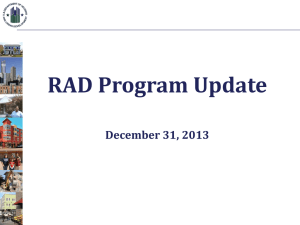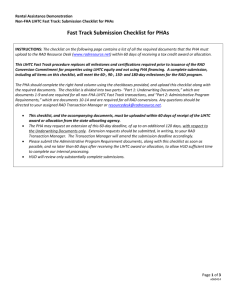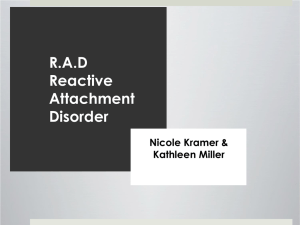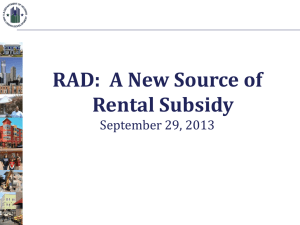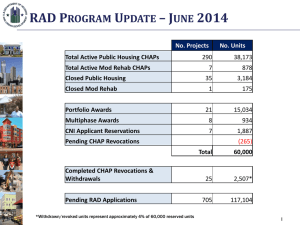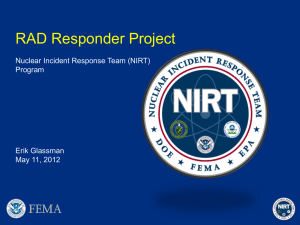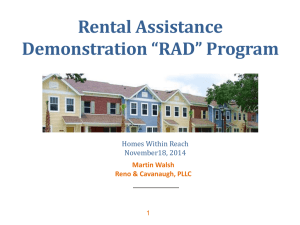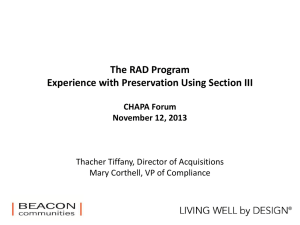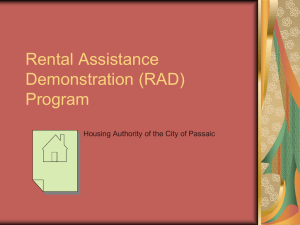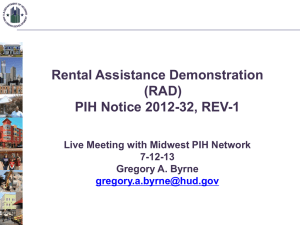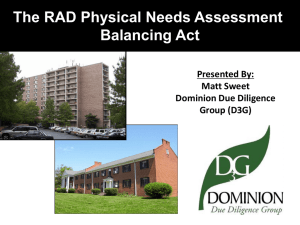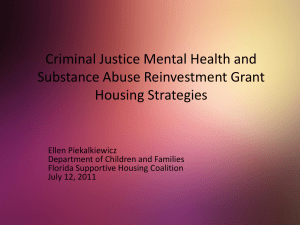LHC Mini Meeting 2014
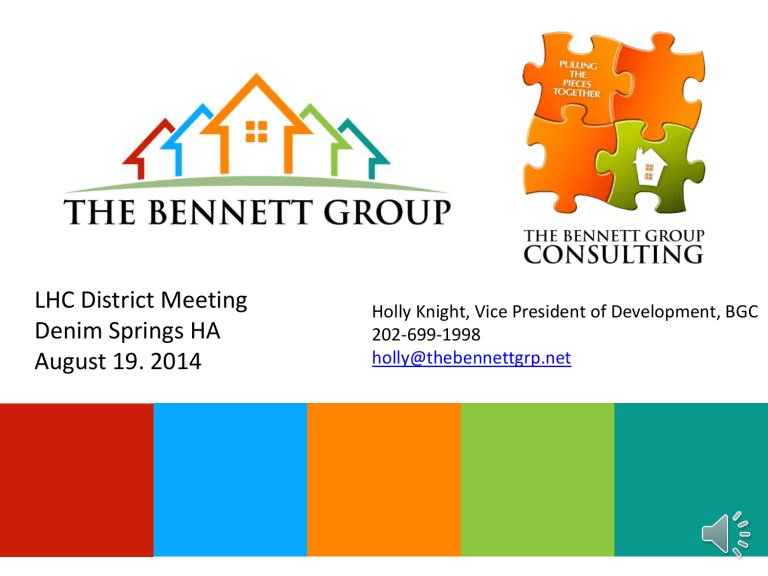
LHC District Meeting
Denim Springs HA
August 19. 2014
Holly Knight, Vice President of Development, BGC
202-699-1998 holly@thebennettgrp.net
Goal of RAD
In order to preserve the public housing stock convert its assistance to the project-based Section 8 platform, which will:
1.
Stabilize funding
2.
3.
4.
Create access to private capital
Streamline HUD programs
Enhance housing options for residents
In order to convert the entire public housing stock,
HUD continues to ask Congress for authority and for funds.
Challenge and tools
CHALLENGE:
• The Public Housing program has remained underfunded for more than 30 years, leading to ~$26 billion capital backlog
• The nation’s Public Housing stock is struggling, and has significant capital repair needs
NEW TOOL:
• Conversion to the project-based Section 8 programs provides an opportunity to invest billions into the public housing stock
• The Rental Assistance Demonstration (RAD) allows PHAs to undertake this conversion for some units
• HUD has achieved its goal of standing up this new tool, attracting many PHAs to participate
• Only 60,000 units are currently able to convert; lifting cap will make the RAD tool available to all PHAs who want to use it.
Lift the RAD Cap Coalition: website with resources
Early RAD conversations
•
•
•
•
•
•
•
“RAD will only work for public housing projects with low needs”
“RAD is for PHAs in strong markets.”
“RAD is for small PHAs”
“Everyone will convert to PBRA”
“Everyone will convert to PBV”
“RAD only works with 9% Low Income Housing Tax Credits and there’s not enough to go around”
“RAD will only work with FHA mortgage insurance – 99% of these transactions will go FHA”
• “RAD won’t work”
P ERCENTAGE OF C URRENT PH U NITS BY HUD R EGION THAT HAVE
A PPLIED FOR RAD
7% 3% 15% 6%
7%
18%
16%
21%
22%
21%
Note: This data reflects the percentage of PH units in each HUD region that have applied for RAD; note that units are considered public housing until the RAD closing is complete.
5
Whole Portfolio Conversions
• 76% of the PHAs with CHAP awards have proposed to convert their entire stock,
•
•
• including
52 small PHA (<250 units)
29 medium PHA (250-1,250 units)
26 large PHAs (>1,250 units)
RAD Helping PHAs Address Challenges
Indicated PHA Objectives
• Complete repairs – range of moderate repairs, substantial rehab and New Construction
• ~ 20% of projects planning Demolition and New Construction (on site or off site)
• Average repair hard costs of ~ $45,000 per unit ($25,000 per unit excluding new construction)
• Place mixed-finance properties on solid financial footing for long term (~ 15% of projects)
• Thin densities/mix-incomes via transfer of assistance
• Streamline programs
Reviewing Applications on the Waitlist
• Secretary Donovan letter 2/20 confirms HUD will review the
~ 685 applications above the 60,000 unit cap
•
•
Instruction from Secretary:
Review applications and prepare conditional approvals.
• Next two weeks conditional CHAPs to be issued
• When cap is lifted, HUD will issue CHAPs to all approved applications and process in order of the waiting list.
• HUD will use the RAD Notice for these projects but will use
FY14 funding levels to calculate the rents.
RAD Update
HUD has asked for RAD cap to be lifted in 2015 budget
RAD Application by
RAD Application update
Application Overall Sources of Funding
RAD Application tax credits
Operating Subsidy Funding
OFND Annual Amount
$6 000 000 000
$5 031 106 183
$5 000 000 000
$4 900 000 000 $4 921 341 060
$4 594 294 060 $4 611 918 201
$4 149 983 999
$4 000 000 000
$3 000 000 000
$2 000 000 000
$1 000 000 000
$-
89.20
%
2014
82%
2013
94.968% 100%
2012 2011
OFND Annual Amount (U.S.) Proration
103%
2010
88.42%
2009
Capital Fund Capital Funding Trends
2,5E+09
$2 341 258 000 $2 365 835 000
2E+09
$1 910 035 000
$1 790 000 000 $1 800 000 000
$1 696 372 000
1,5E+09
1E+09
500000000
0
2009 2010 2011 2012 2013 2014
1 2 3 4 5 6
PH Development Resources
Note: Not listed PHA PBV at FMR, PHA Cost Center Funds, Admin Fees
What is the future?
• Losing affordable housing
• $26 Billion capital investment need
• Unpredictable and insufficient funds
• Limited investments in public housing
• Aging housing stock: average PH is 43 years old
• Marketability and curb appeal
• Rules and regulations increasing
• Under performing PHAs and consolidation
• Funding trends decreasing
• HUDs program consolidation goals
Sample Public Housing Conversion
Per Unit Monthly (PUM) – Same funding
$900
$800
$700
$600
Operating Fund
$200
Operating Fund
$330
2013 Funding
$164
$500
2013 Funding
$400
$95
$300
$200
Tenant Payment
$150
T enant Payment
$318
$100
$-
Pre-Conversion
Housing Assistance
Payment
Assistance
Payment
$474
Tenant Payment
T
$150
$318
Post-Conversion
PH Options
Why RAD
Builds on a more stable funding platform
Lock in funding
Better than Capital Fund Finance, Leveraged Op Sub, or EPC
Leverage private capital to address physical needs and preserve your units
Leverage 4% LIHTC get 30% project equity
Leverage 9% LIHTC get 60+% project equity
Leverage developer fees, seller take back finance, ground lease
Apply for grants HOME, Federal Home Loan Bank
Provides a great deal of regulatory and reporting relief
Saves in reporting to HUD, policies, and oversight more with board and PHA
Why RAD
Procurement with developer partner is simplified
Expenses
Gives real estate opportunities
Can move HAP contract as needed
Can move out of flood zones/hazard zones/undesirable areas
Can use non federal funds to purchase properties or land
Benefits of partnering for expiring LIHTC, Home projects,
HUD Multifamily developments
Best and highest use of assets
Feasibility, Marketability, and Sustainability
RAD flexibility
Transfer assistance from unworkable units prior to conversion
Market accommodations in meeting 1-for-1 preservation
(e.g., convert efficiencies to 1 bdrms; long-term vacant units)
Combine RAD & agency PBVs or SAC TPVs>PBVs
Flexibility to reduce densities, replace housing off-site, produce mixed income communities
Allows PHA to undertake renovations immediately or after conversion, as warranted
Demolition/New Construction allowed
Ability to “bundle” project applications for flexibility with initial contract rents
Backlog of Capital Needs
Capital repair needs of $23,365 per unit
Needs at your PHA
Roof - $8,000
3 Bedroom 504 Compliance $25-35,000
ADA Site compliance $10-15,000
HVAC replacement -$4,000
Water Heater - $350
Site Soil Erosion- $20,000
Appliances –Range $450 / Fridge $550
Show the PHA the Money
• The RAD options:
• Modest rehab with no debt
• Modest rehab with debt only
• Moderate rehab with debt and 4% LIHTCs
• Major rehab or replacement with debt and 9% LIHTCs
• These are funding sources that are not conveniently available to small PHAs
• A conversion of all LIPH units eliminates the HUD requirements for:
• Procurement
• Annual and Five‐ Year Plans
• PHAS
• REAC (if…PBV)
• You Get to Keep the Money – no offsets, developer fees, seller take back financing, cash flow options
What can RAD do now?
15-20 year, renewable contracts with use agreement
Predictable initial contract rent setting; annual operating cost adjustments for inflation (OCAF)
Established replacement and operating reserves; standard industry underwriting requirements
RAD HAP funding begins at construction closing
No limitations on use of project cash flow
PHA ownership/control similar to LIHTC practices
Long-term affordability ensured
RAD Similar and Different to mixed finance
• Similarities:
Real Estate Transaction same
Rent/Income
Reporting to 3 rd parties
Physical needs assessment is a driver
• Differences:
PHAs want to self manage
RAD PCNA tool
Complicated HUD regulations
Lower Income to project
Expenses higher may need to be adjusted
Type of 3 rd party reporting HUD versus Investor
• Benefits of PHA Partner
Invested in community
Familiar with social services
Knows the community partners
Has managed PH inventory on shoestring budget
Familiar with compliance
RAD Transaction Concerns
• Timing
• Tax credit compliance versus HUD compliance
• Rent calculation and income qualification
• Boards and their role changes
• Limited knowledge of mixed finance
• Management
• Ownership changes impact pilot and taxes
• Investors and HFA unfamiliar with PHAs
• RAD rents are low
• HUD conversion requirements
• PBV/PBRA
• PHA Plan
• Site and neighborhood
• Elderly designation
• Environmental
• Relocation (URA)
• Affirmatively Furthering Fair Housing
Change
